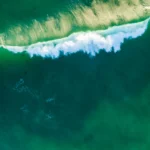
There are usually some leftover frothy bits that cling to the sand when the waves crash onto the shore. During windy days, this foamy stuff can even be lifted off the ground and blown around. What is it? And is it dangerous to touch it or let the dog run around in it?
It’s seafoam, and it is not nearly as green as the color we call sea foam. It’s usually whitish, though it’s probably a little dingy rather than being sparkling white. Sometimes it’s more of a reddish-brown, though, and that’s the seafoam to watch out for.
Seawater is 96.5 percent water and 2.5 percent salt. That only adds up to 99 percent, so what’s the other 1 percent? A lot of things. According to the National Oceanic and Atmospheric Administration (NOAA), it’s “proteins, fats, dead algae, detergents, and other pollutants,” plus other bits of organic and inorganic matter. When these particles get agitated by wind and waves, they froth. You can create the same effect by putting some seawater in a bottle and shaking it.
The bubbles happen because of molecules called surfactants, which Popular Science explains are “sticky molecules that cling to the surface between water and air.” These surfactants can come from natural sources, like algae and seaweed, or from human pollution, like fertilizers, detergents, and sewage. Ew.
One end of the molecule is hydrophobic – it repels water. The other end is hydrophilic – it attracts water. The easiest shape for these molecules to form is a sphere, with the hydrophobic ends on the inside and the hydrophilic ends pointing outward. Spheres (even if they aren’t perfect) make bubbles. And a lot of bubbles make seafoam!
Now, about that reddish-brown sea foam. That’s often due to phytoplankton, also known as algae blooms, which is a natural phenomenon. These tiny organisms release toxins that aren’t good for you, your dog, the birds, or anything, really. The toxins can irritate the eyes and ears, and even the respiratory system.
The white foam may not be toxic, but that doesn’t mean it’s harmless. When the weather gets completely out of control, the churning of the water creates a lot of seafoam. Like, a lot. In the winter of 2020, a king tide in Washington state with 25-foot (nearly 8-meter) waves created a “blender effect” that churned up sea foam as high as a man’s chest. Later that spring and halfway around the world, so much seafoam appeared in the Netherlands that it killed five very experienced surfers.







